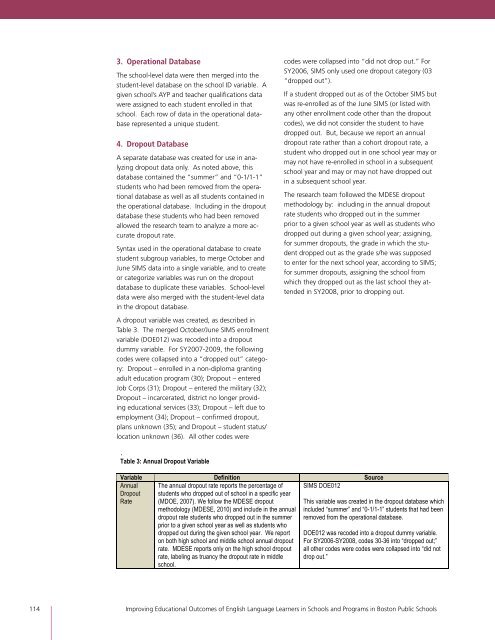Full Report - Center for Collaborative Education
Full Report - Center for Collaborative Education
Full Report - Center for Collaborative Education
You also want an ePaper? Increase the reach of your titles
YUMPU automatically turns print PDFs into web optimized ePapers that Google loves.
3. Operational Database<br />
The school-level data were then merged into the<br />
student-level database on the school ID variable. A<br />
given school’s AYP and teacher qualifications data<br />
were assigned to each student enrolled in that<br />
school. Each row of data in the operational database<br />
represented a unique student.<br />
4. Dropout Database<br />
A separate database was created <strong>for</strong> use in analyzing<br />
dropout data only. As noted above, this<br />
database contained the “summer” and “0-1/1-1”<br />
students who had been removed from the operational<br />
database as well as all students contained in<br />
the operational database. Including in the dropout<br />
database these students who had been removed<br />
allowed the research team to analyze a more accurate<br />
dropout rate.<br />
Syntax used in the operational database to create<br />
student subgroup variables, to merge October and<br />
June SIMS data into a single variable, and to create<br />
or categorize variables was run on the dropout<br />
database to duplicate these variables. School-level<br />
data were also merged with the student-level data<br />
in the dropout database.<br />
A dropout variable was created, as described in<br />
Table 3. The merged October/June SIMS enrollment<br />
variable (DOE012) was recoded into a dropout<br />
dummy variable. For SY2007-2009, the following<br />
codes were collapsed into a “dropped out” category:<br />
Dropout – enrolled in a non-diploma granting<br />
adult education program (30); Dropout – entered<br />
Job Corps (31); Dropout – entered the military (32);<br />
Dropout – incarcerated, district no longer providing<br />
educational services (33); Dropout – left due to<br />
employment (34); Dropout – confirmed dropout,<br />
plans unknown (35); and Dropout – student status/<br />
location ! unknown (36). All other codes were<br />
!<br />
Table 3: Annual Dropout Variable<br />
codes were collapsed into “did not drop out.” For<br />
SY2006, SIMS only used one dropout category (03<br />
“dropped out”).<br />
If a student dropped out as of the October SIMS but<br />
was re-enrolled as of the June SIMS (or listed with<br />
any other enrollment code other than the dropout<br />
codes), we did not consider the student to have<br />
dropped out. But, because we report an annual<br />
dropout rate rather than a cohort dropout rate, a<br />
student who dropped out in one school year may or<br />
may not have re-enrolled in school in a subsequent<br />
school year and may or may not have dropped out<br />
in a subsequent school year.<br />
The research team followed the MDESE dropout<br />
methodology by: including in the annual dropout<br />
rate students who dropped out in the summer<br />
prior to a given school year as well as students who<br />
dropped out during a given school year; assigning,<br />
<strong>for</strong> summer dropouts, the grade in which the student<br />
dropped out as the grade s/he was supposed<br />
to enter <strong>for</strong> the next school year, according to SIMS;<br />
<strong>for</strong> summer dropouts, assigning the school from<br />
which they dropped out as the last school they attended<br />
in SY2008, prior to dropping out.<br />
Variable Definition Source<br />
Annual The annual dropout rate reports the percentage of SIMS DOE012<br />
Dropout students who dropped out of school in a specific year<br />
Rate (MDOE, 2007). We follow the MDESE dropout This variable was created in the dropout database which<br />
methodology (MDESE, 2010) and include in the annual included “summer” and “0-1/1-1” students that had been<br />
dropout rate students who dropped out in the summer<br />
prior to a given school year as well as students who<br />
removed from the operational database.<br />
dropped out during the given school year. We report DOE012 was recoded into a dropout dummy variable.<br />
on both high school and middle school annual dropout For SY2006-SY2008, codes 30-36 into “dropped out;”<br />
rate. MDESE reports only on the high school dropout all other codes were codes were collapsed into “did not<br />
rate, labeling as truancy the dropout rate in middle<br />
school.<br />
drop out.”<br />
114 Improving <strong>Education</strong>al Outcomes of English Language Learners in Schools and Programs in Boston Public Schools


